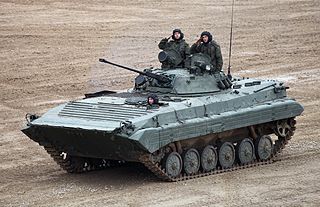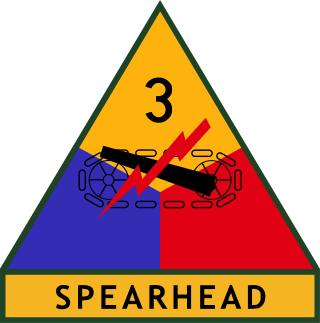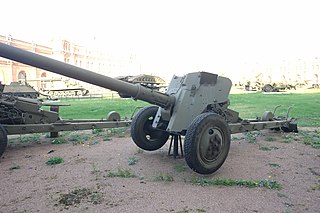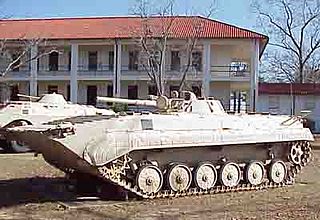
An infantry fighting vehicle (IFV), also known as a mechanized infantry combat vehicle (MICV), is a type of armoured fighting vehicle used to carry infantry into battle and provide direct-fire support. The 1990 Treaty on Conventional Armed Forces in Europe defines an infantry fighting vehicle as "an armoured combat vehicle which is designed and equipped primarily to transport a combat infantry squad, and which is armed with an integral or organic cannon of at least 20 millimeters calibre and sometimes an antitank missile launcher". IFVs often serve both as the principal weapons system and as the mode of transport for a mechanized infantry unit.

During the early stages of the Iran-Iraq War, Iraq under the rule of Saddam Hussein imported a number of T-72 tanks from the Soviet Union and Poland. The tanks saw service in both the Gulf War and the Iraq War. In the 1980s, Iraq also established a factory to retrofit and repair T-72s, and started the Lion of Babylon project with the intent to assemble T-72s locally.

The Bradley Fighting Vehicle (BFV) is a tracked armored fighting vehicle of the United States developed by FMC Corporation and manufactured by BAE Systems Land & Armaments, formerly United Defense. The BFV is named for U.S. General Omar Bradley.

The BMP-1 is a Soviet amphibious tracked infantry fighting vehicle that has been in service from 1966 to the present. BMP stands for Boyevaya Mashina Pyekhoty 1, meaning "infantry fighting vehicle, 1st serial model". The BMP-1 was the first mass-produced infantry fighting vehicle (IFV) of the Soviet Union. It was called the M-1967, BMP and BMP-76PB by NATO before its correct designation was known.

The BMP-2 is an amphibious infantry fighting vehicle introduced in the 1980s in the Soviet Union, following on from the BMP-1 of the 1960s.

The 3rd Armored Division was an armored division of the United States Army. Unofficially nicknamed the "Third Herd", the division was first activated in 1941 and was active in the European Theater of World War II. The division was stationed in West Germany for much of the Cold War and also participated in the Persian Gulf War. On 17 January 1992, still in Germany, the division ceased operations. In October 1992, it was formally inactivated as part of a general drawing down of U.S. military forces at the end of the Cold War.

The M113 is a fully tracked armored personnel carrier (APC) that was developed and produced by the FMC Corporation. The M113 was sent to United States Army Europe in 1961 to replace the mechanized infantry's M59 APCs. The M113 was first used in combat in April 1962 after the United States provided the South Vietnamese army (ARVN) with heavy weaponry such as the M113, under the Military Assistance Command, Vietnam (MACV) program. Eventually, the M113 was the most widely used armored vehicle of the U.S. Army in the Vietnam War and was used to break through heavy thickets in the midst of the jungle to attack and overrun enemy positions. It was largely known as an "APC" or an "ACAV" by the allied forces.

The Battle of 73 Easting was fought on 26 February 1991, during the Gulf War, between Coalition armored forces and Iraqi armored forces. It was named for a UTM north–south coordinate line that was used as a phase line by Coalition forces to measure their progress through the desert. The battle was later described by Lt. John Mecca, a participant, as "the last great tank battle of the 20th century." This battle took place several hours after another, smaller, tank battle at Al Busayyah.

The Battle of Medina Ridge was a tank battle fought on the 27 February 1991, during the Gulf War, between the U.S. 1st Armored Division and the 2nd Brigade of the Iraqi Republican Guard Medina Luminous Division outside Basra, Iraq. The U.S. 3rd Brigade, 3rd Infantry Division, was also a major contributor, by leading the attack. Iraq's Adnan Motorized Division was also a participant. Medina Ridge is the name American troops gave to a low rise, approximately seven miles (11 km) long.

The Battle of Norfolk was a tank battle fought on February 27, 1991, during the Persian Gulf War, between armored forces of the United States and United Kingdom, and those of the Iraqi Republican Guard in the Muthanna Province of southern Iraq. The primary participants were the U.S. 2nd Armored Division (Forward), 1st Infantry Division (Mechanized), and the Iraqi 18th Mechanized and 9th Armoured Brigades of the Republican Guard Tawakalna Mechanized Infantry Division along with elements from eleven other Iraqi divisions. The 2nd Armored Division (Forward) was assigned to the American 1st Infantry Division as its 3rd maneuver brigade due to the fact that one of its brigades was not deployed. The 2nd Armored Division (Forward)'s Task Force 1-41 Infantry would be the spearhead of VII Corps. The British 1st Armoured division was responsible for protecting the right flank of VII Corps, their main adversary being the Iraqi 52nd Armored Division and multiple infantry divisions. It was the final battle of the war before the unilateral ceasefire took effect.

The Battle of Wadi al-Batin, also known as the Battle of Ruqi Pocket, took place before the beginning of the Desert Storm operations on 16 February 1991. This is not to be confused with the "Battle of Wadi al-Batin" which was fought later in the four-day ground war between elements of the 1st Cavalry Division and the Iraqi Republican Guard.
MICV-65, short for Mechanized Infantry Combat Vehicle, 1965, was a US Army project that studied a number of armored fighting vehicles that would replace the M113 and M114 as well as take on a variety of new roles. A number of designs were studied as part of the MICV project, but none of them entered service for a variety of reasons. Nevertheless, experience gained in the MICV project eventually led to the M2 Bradley, which incorporates many of the MICV concepts.
The Soviet BMP-1 is a tracked, amphibious infantry fighting vehicle (IFV) with a long service history.

The BMP series were among the first production line infantry fighting vehicles. Included in the series are the mainline BMPs, the airborne variant BMDs, and licensed modified and reverse engineered versions. BMP stands for Boyevaya Mashina Pekhoty, meaning "infantry fighting vehicle". They were initially developed in the 1960s in the Soviet Union.

The M2 Bradley, or Bradley IFV, is an American infantry fighting vehicle that is a member of the Bradley Fighting Vehicle family. It is manufactured by BAE Systems Land & Armaments.

The Battle of Rumaila, also known as the Battle of the Causeway or the Battle of the Junkyard, was a controversial attack that took place on March 2, 1991, two days after President Bush declared a ceasefire, near the Rumaila oil field in the Euphrates Valley of southern Iraq, when the U.S. Army forces, mostly the 24th Infantry Division under Major General Barry McCaffrey engaged and nearly annihilated a large column of withdrawing Iraqi Republican Guard armored forces during the immediate aftermath of the Gulf War.
This article deals with the history and development of tanks of the Soviet Union and its successor state, the Russian Federation; from their first use after World War I, into the interwar period, during World War II, the Cold War and modern era.

Task Force 1-41 Infantry was a U.S. Army heavy battalion task force which took part in the Gulf War of January – March 1991. It was also known as Task Force Iron. Task Force 1-41 Infantry was the first coalition force to breach the Saudi Arabian border on 15 February 1991 and conduct ground combat operations in Iraq engaging in direct and indirect fire fights with the enemy on 17 February 1991. It was the spearhead of VII Corps. The Task Force served at the Battle of 73 Easting and the Battle of Norfolk where it was assigned to the U.S. 1st Infantry Division. It engaged and destroyed elements of 11 Iraqi divisions by the end of combat operations. This includes a significant role in the destruction of 4 Iraqi armored brigades at the Battle of Norfolk. Task Force 1-41 Infantry was awarded a Valorous Unit Award for its accomplishments during combat operations. It consisted primarily of the 1st Battalion, 41st Infantry Regiment, 3rd Battalion, 66th Armor Regiment, and the 4th Battalion, 3rd Field Artillery Regiment all being part of the 2nd Armored Division (Forward), based at Lucius D. Clay Kaserne, 24 kilometres (15 mi) north of Bremen, in the Federal Republic of Germany. Task Force 1-41 was commanded by Lieutenant Colonel James L. Hillman.

The Battle of Kuwait International Airport occurred on February 27, 1991, during the 1st Gulf War. It was a tank battle between the United States and Iraq. Despite being a very large battle it is often overlooked compared to the other battles which took place during the war. No less than elements of 18 divisions total participated in this battle. US Army Special Forces units and multiple Iraqi Commando units were also in theatre. In reality the battle took place over a span of three days despite the primary battle at Kuwait International Airport lasting only one day. Much of the combat actually took place en route to the airport. The battle featured the "Reveille Engagement" which went on to become the biggest and fastest tank battle in United States Marine Corps' entire history.

















